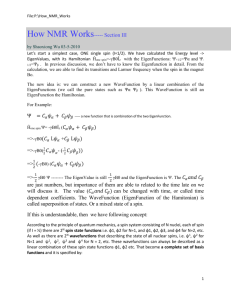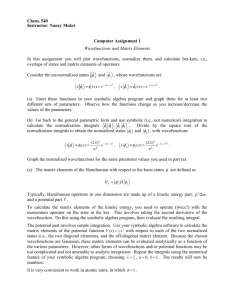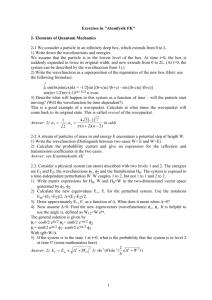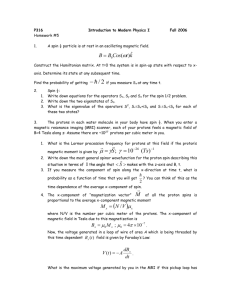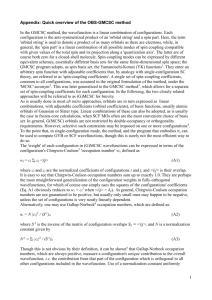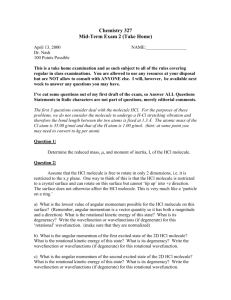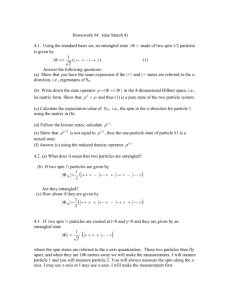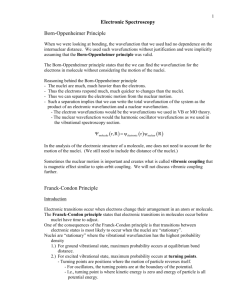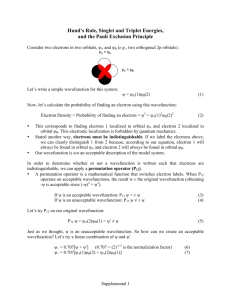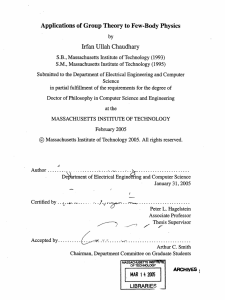FLORIDA INTERNATIONAL UNIVERSITY
advertisement
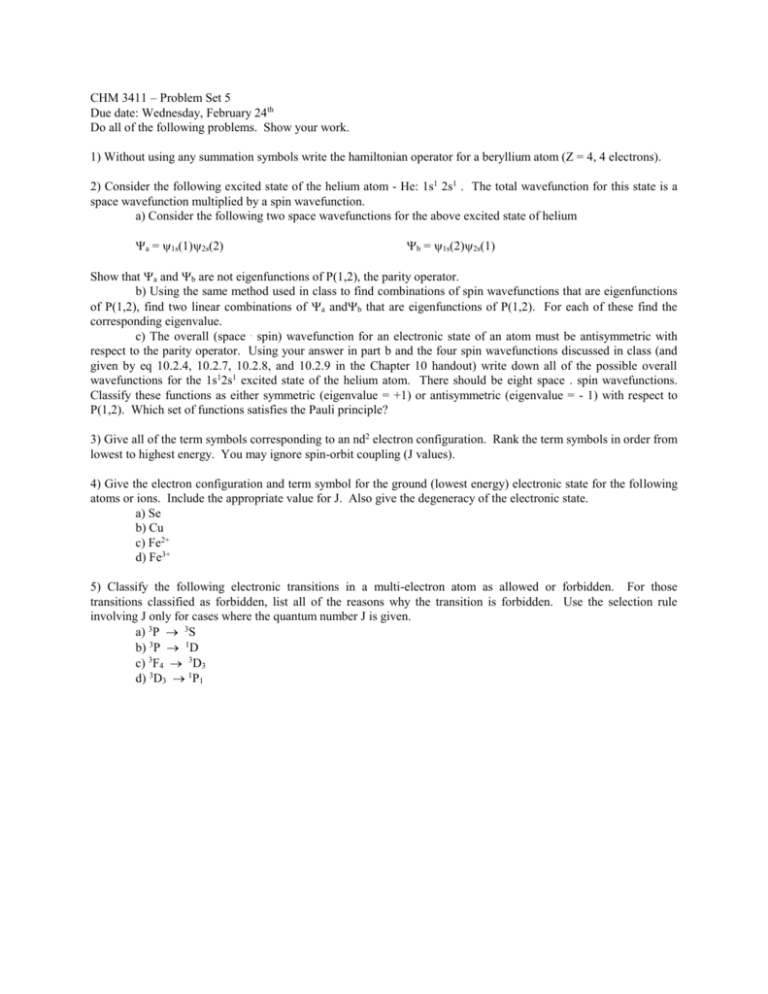
CHM 3411 – Problem Set 5
Due date: Wednesday, February 24th
Do all of the following problems. Show your work.
1) Without using any summation symbols write the hamiltonian operator for a beryllium atom (Z = 4, 4 electrons).
2) Consider the following excited state of the helium atom - He: 1s1 2s1 . The total wavefunction for this state is a
space wavefunction multiplied by a spin wavefunction.
a) Consider the following two space wavefunctions for the above excited state of helium
a = 1s(1)2s(2)
b = 1s(2)2s(1)
Show that a and b are not eigenfunctions of P(1,2), the parity operator.
b) Using the same method used in class to find combinations of spin wavefunctions that are eigenfunctions
of P(1,2), find two linear combinations of a andb that are eigenfunctions of P(1,2). For each of these find the
corresponding eigenvalue.
c) The overall (space . spin) wavefunction for an electronic state of an atom must be antisymmetric with
respect to the parity operator. Using your answer in part b and the four spin wavefunctions discussed in class (and
given by eq 10.2.4, 10.2.7, 10.2.8, and 10.2.9 in the Chapter 10 handout) write down all of the possible overall
wavefunctions for the 1s12s1 excited state of the helium atom. There should be eight space . spin wavefunctions.
Classify these functions as either symmetric (eigenvalue = +1) or antisymmetric (eigenvalue = - 1) with respect to
P(1,2). Which set of functions satisfies the Pauli principle?
3) Give all of the term symbols corresponding to an nd2 electron configuration. Rank the term symbols in order from
lowest to highest energy. You may ignore spin-orbit coupling (J values).
4) Give the electron configuration and term symbol for the ground (lowest energy) electronic state for the following
atoms or ions. Include the appropriate value for J. Also give the degeneracy of the electronic state.
a) Se
b) Cu
c) Fe2+
d) Fe3+
5) Classify the following electronic transitions in a multi-electron atom as allowed or forbidden. For those
transitions classified as forbidden, list all of the reasons why the transition is forbidden. Use the selection rule
involving J only for cases where the quantum number J is given.
a) 3P 3S
b) 3P 1D
c) 3F4 3D3
d) 3D3 1P1
Solutions
1)
H = - (2/2m) 12 - (2/2m)22 - (2/2m)32 - (2/2m)42 - (4e2/40) (1/r1) - (4e2/40) (1/r2)
- (4e2/40) (1/r3) - (4e2/40) (1/r4) + (e2/40) (1/r12) + (e2/40) (1/r13) + (e2/40) (1/r14)
+ (e2/40) (1/r23) + (e2/40) (1/r24) + (e2/40) (1/r34)
Note there are three types of terms: Kinetic energy for the electrons, electron-nuclear potential
energy, and electron-electron kinetic energy.
2)
a)
P(1,2) 1s(1)2s(2) = 1s(2)2s(1) (const) 1s(1)2s(2)
P(1,2) 1s(2)2s(1) = 1s(1)2s(2) (const) 1s(2)2s(1)
b)
By analogy with how we proceeded with the spin functions, we define two linear combinations of
the space wavefunctions as
+ = (1/2)1/2 [1s(1)2s(2) + 1s(2)2s(1)]
- = (1/2)1/2 [1s(1)2s(2) - 1s(2)2s(1)]
To test whether these are eigenfunctions of the parity operator we substitute into the eigenvalue equation
P(1,2) + = P(1,2) { (1/2)1/2 [1s(1)2s(2) + 1s(2)2s(1)] }
= { (1/2)1/2 [1s(2)2s(1) + 1s(1)2s(2)] }
= (+1) { (1/2)1/2 [1s(1)2s(2) + 1s(2)2s(1)] }
and
P(1,2) - = P(1,2) { (1/2)1/2 [1s(1)2s(2) - 1s(2)2s(1)] }
= { (1/2)1/2 [1s(2)2s(1) - 1s(1)2s(2)] }
= (-1) { (1/2)1/2 [1s(1)2s(2) - 1s(2)2s(1)] }
So + is an eigenfunction of P(1,2), with eigenvalue +1, and - is an eigenfunction of P(1,2) with eigenvalue -1.
c) The eight possible combinations of spin . space wavefunctions and their corresponding eigenvalues when
operated on by P(1,2) are given below
spin . space wavefunction
eigenvalue P(1,2)
MS
+ (1) (2)
+1
+1
+ +
+1
0
+ (1) (2)
+1
-1
X
+ -
-1
0
X
- (1) (2)
-1
+1
X
- +
-1
0
X
- (1) (2)
-1
-1
- -
+1
0
where we recall that
+ = (1/2)1/2 [(1)(2) + (1)(2)]
- = (1/2)1/2 [(1)(2) - (1)(2)]
The four combinations of space . spin wavefunctions that are antisymmetric with respect to P(1,2), and therefore
satisfy the Pauli principle, are marked with X.
3) This will be fun. There are 10!/2!8! = 45 combinations. They are listed below
m=+2 m=+1 m=0
____
____
____
m=-1
____
m=-2
____
ML
MS
4
3
3
2
2
1
1
0
0
3
3
2
2
1
1
0`
0
2
1
1
0
0
0
1
0
1
0
1
0
1
0
0
-1
0
-1
0
-1
0
-1
0
1
0
1
0
-1
-1
1
1
0
0
-1
-1
0
-1
-1
-2
-2
-1
-1
-2
-2
-2
-3
-3
-3
-3
-4
1
0
0
-1
0
-1
0
-1
0
1
0
1
0
0
-1
0
-1
0
1
0
0
-1
0
We can organize the results in a table, as given below
ML
4
3
2
1
0
-1
-2
-3
1
1
2
2
2
1
1
2
3
4
5
4
3
2
1
1
2
2
2
1
1
-4
MS
1
0
1
-1
1
We now remove states using the procedure discussed in class until all of the states have been accounted for. If we do
this we get the following results (degeneracies are also shown).
L=4
S=0
1
g=9
L=3
S=1
3
g = 21
L=2
S=0
1
g=5
L=1
S=1
3
g=9
L=0
S=0
1
g=1
G
F
D
P
S
Notice that we have 45 states, as expected. The order of these states in energy is
3
F < 3P < 1G < 1D < 1S
4)
a) Se: [Ar] 4s2 3d10 4p4
m=+1 m=0
____
____
m=-1
____
ML = 1, so L = 1
MS = 1, so S = 1
J = 2, 1, 0. More than half filled, so highest J is lowest in energy.
3
P2 , g = (2J+1) = 5
b) Cu: [Ar] 4s1 3d10
m=0
____
ML = 0, so L = 0
MS = 1/2, so S = 1/2
J = 1/2
2
S1/2, g = (2J+1) = 2
c) Fe: [Ar] 4s2 3d6
Fe2+: [Ar] 3d6
m=+2 m=+1 m=0
____
____
____
m=-1
____
m=-2
____
ML = 2, so L = 2
MS = 2, so S = 2
J = 4, 3, 2, 1, 0. More than half filled, so highest J is lowest in energy.
5
D4 , g = (2J+1) = 9
d) Fe: [Ar] 4s2 3d6
Fe3+: [Ar] 3d5
m=+2 m=+1 m=0
____
____
____
m=-1
____
m=-2
____
ML = 0, so L = 0
MS = 5/2, so S = 5/2
J = 5/2.
6
S5/2 , g = (2J+1) = 6
5)
a) 3P 3S
Allowed
b) 3P 1D
Forbidden, since S = -1.
c) 3F4 3D3
Allowed.
d) 3D3 1P1
Forbidden for two reasons, because S = -1 and because J = - 2.
